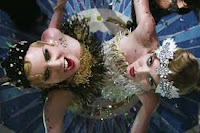Over the weekend I saw the new Baz Luhrmann 3-D interpretation of F. Scott Fitzgerald's The Great Gatsby. Having taught that novel for twenty+ years, I know most of its lines by heart. Did I mention it's one of my favorites? I've also viewed the '74 film starring Robert Redford probably forty times in my classroom. Make no mistake--I love Robert Redford. That '74 film, however, is ponderous and, at times, poorly directed, but it stuck with the book and its 1920's music is haunting..."What'll I do when you are far away and I am blue---what'll I do?" Love that music. So it was with great skepticism that I watched the new film version.
I won't summarize the story since you probably know it if you're reading this post. I will say that the English teacher in me has mixed feelings about the film, but the movie-goer in me would still recommend it as intriguing entertainment.
If you can survive the frenetic, high-on-steroids,
first half of the film, you'll like the second half better as a reader of the book. Luhrmann is giving us a 2013 interpretation of the novel and that means a modern soundtrack that will appeal to the 20-something crowd. I didn't mind the music. His take on 21st century consumerism, invasive media, and scandal-worshipping masses is in-your-face obvious and certainly true of the 20's also. But he would have been wiser to cut back on the parties and concentrate more on the human tragedy at the core of the story.
The film has two parts and the mood totally changes with the dinner party at the Buchannan's. Where Luhrmann truly succeeds is in showing the illusion and artifice Gatsby has created to win Daisy Fay Buchannan back. His entire life, his false history, and his house are stylish conjurer's tricks, as fake as the unread and uncut books in his library. I wasn't sure I'd like Leonardo DiCaprio as Gatsby, but I thought he was amazing. He captured both the self-confidence and swagger of the character and also his desperation as he sees his dream falling apart. He is a glittering illusion and a handsome and charming one at that.
George and Myrtle Wilson are well done and definitely capture the characters as I pictured them. Daisy, played by Carey Mulligan, is the glittering embodiment of Gatsby's dreams--but other than that, she fades into the scenery. In the novel and earlier film I found her annoying, but she didn't strike me at all in this film. I was not impressed by Tobey Maguire as Nick, but he drew a difficult part to play. He is too muted. His joy at believing in Gatsby and his eventual disillusionment with the whole situation are played on a middle scale without sharp edges.
Three key points were left out--pieces that would have made the tragedy more compelling. Two scenes done with great tension are the dinner party at the Buchannan's and the following scene in a New York City hotel.
 |
| The '74 film |
The second disappearance from book to film was the visit by James Gatz's (Jay Gatsby) father from Minnesota. In the novel Nick has to make all the funeral arrangements because there is no one else. Gatsby's father shows up and confirms for Nick that all of Gatsby's story about his real past is true, including his childhood yearnings to be successful and rich. Henry Gatz accompanies Nick to the funeral where only a few people--mostly servants--attend, revealing how lonely and superficial Gatsby's life really was. It was all about his quest for Daisy. Luhrmann chose instead to eliminate this scene and emphasize the paparrazi pushing each other around Gatsby's casket at the funeral home.
The last scene--a pivotal one--Luhrmann left out was Nick's meeting on Fifth Avenue with Tom and Daisy the following October after Gatsby's death. Nick finally realizes their shallow lives, their egotism, and their carelessness, and he can't forgive them for their parts in the death of Gatsby and his dream.
All three of these omissions would have made the tragedy deeper, but Luhrmann chose to leave them out. They bring the reader to Gatsby's side with Nick, but Luhrmann's film is devoid of emotional ties with the characters and is filled instead with the Hollywood version of the 20's.
Luhrmann added a frame that bothered me at first. Nick is telling--then typing--his story from a sanitarium. While I'd dispute the doctor's diagnosis that Nick is an alcoholic and suffers from mental illness, I did eventually like the reminder that he--Nick Carraway--is truly the narrator of the story. We see it through his eyes. Even Fitzgerald's words occasionally appear and fall off the screen as Nick types them. It is through Nick that we understand the tragedy of Jay Gatsby, and although it's a controversial aspect of the movie, I liked the frame.
Overall I'd recommend The Great Gatsby as a 21st century re-telling of the story. Even as an English teacher who loves the novel, I found the new film entertaining.








